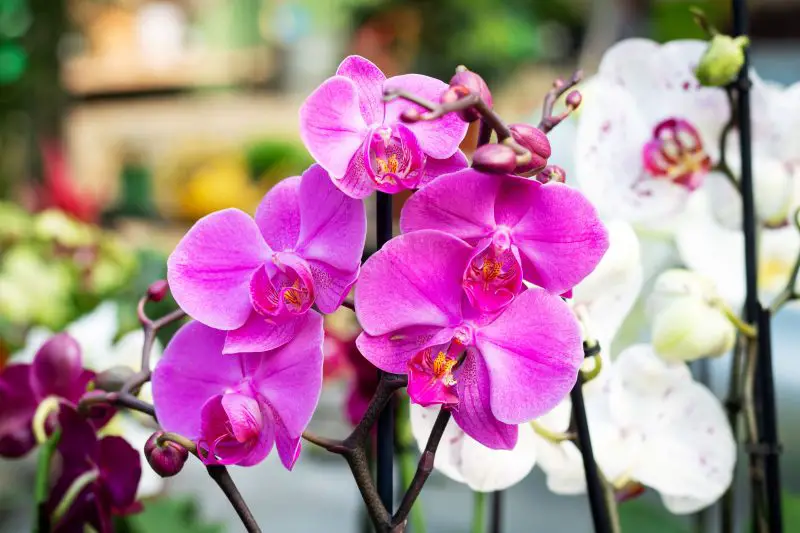Orchids are among the most captivating houseplants, admired for their exotic blooms and delicate beauty. However, many orchid enthusiasts face one common challenge—watering them correctly. Understanding how often to water orchids is crucial to keeping them healthy, preventing root rot, and encouraging them to rebloom. Unlike many houseplants, orchids have specific needs based on their growing medium, environment, and species.
This guide explores everything you need to know about watering orchids the right way. From understanding their natural growing conditions to identifying signs of overwatering or underwatering, you will learn how to maintain the perfect balance of moisture for thriving orchids.
Table of Contents
Understanding the Natural Habitat of Orchids

To water orchids correctly, it helps to understand where they naturally grow. Most orchids, especially popular types like Phalaenopsis, Cattleya, and Dendrobium, are epiphytes, meaning they grow on trees rather than in soil. Their roots are exposed to air and absorb moisture from rain and humidity in the environment.
Because of this, orchids are not adapted to constantly wet conditions. Their roots need good airflow and prefer to dry slightly between watering sessions. Replicating these natural conditions indoors or in your garden is essential for keeping your orchids healthy.
Humidity also plays a significant role in their growth. In their natural habitat, orchids receive frequent misting from rain, but the water drains away quickly. This combination of moisture and excellent air circulation is the key to healthy orchid roots.
How Often Should You Water Orchids?
The question of how often to water orchids does not have a one-size-fits-all answer. Several factors determine watering frequency, including orchid type, potting medium, humidity levels, and room temperature. However, a general rule for most orchids is to water once every 5 to 10 days.
While individual needs may vary, a general rule of thumb is to water your orchid once a week. However, always check the potting medium before watering. If it’s still damp, wait a few more days. Overwatering is a common mistake and can lead to root rot. We recommend watering your orchid once a week, but observation is key to ensuring proper care.
Phalaenopsis orchids, the most common variety, typically need watering once a week in moderate conditions. During hotter months or in drier climates, you might need to water them every 4 to 5 days, while in cooler or more humid environments, watering every 10 days may be sufficient.
The best approach is to observe your orchid’s roots and potting medium. If the medium feels dry and the roots appear silvery or whitish, it’s time to water. If the roots are green and the medium is still damp, wait a few more days before watering.
The Best Time of Day to Water Orchids
Timing matters when it comes to watering orchids. The ideal time to water is in the morning. Morning watering allows excess moisture to evaporate throughout the day, reducing the risk of fungal and bacterial infections.
When orchids are watered late in the evening, moisture tends to stay on the leaves and in the crown overnight, creating the perfect environment for rot. Early morning watering mimics natural dew conditions, giving orchids enough time to dry before nightfall.
Additionally, morning watering ensures that your orchid has enough moisture during the hottest part of the day, which is especially important in warmer climates or during summer months.
The Correct Way to Water Orchids
The method of watering is just as important as the frequency. Orchids should be watered thoroughly, allowing water to flow freely through the potting medium. This ensures that all roots receive adequate hydration while flushing out accumulated salts and fertilizers.
When watering, place the pot under running lukewarm water for about 15 seconds or soak it in a bowl of water for a few minutes, then let it drain completely. Never let the orchid sit in standing water, as this leads to root rot.
For orchids in bark-based mediums, water tends to run through quickly, so you may need to water slightly more often. For those in sphagnum moss, which retains moisture longer, water less frequently to avoid soggy roots.
Recognizing Overwatered and Underwatered Orchids
Knowing the signs of improper watering helps you adjust your routine. Overwatering is one of the most common mistakes orchid growers make. Symptoms of overwatering include yellowing leaves, soft and mushy roots, and a musty smell from the potting medium. If left untreated, this can lead to root rot and eventually kill the plant.
Underwatering, on the other hand, causes wrinkled, leathery leaves and dry, brittle roots. The orchid may also fail to bloom if it consistently receives too little water.
Inspecting your orchid’s roots regularly is the best way to determine its health. Healthy orchid roots should be firm and green when moist or silvery white when dry.
Water Quality and Temperature for Orchids
Orchids are sensitive to the type of water used. Tap water with high mineral content can cause salt buildup, which damages roots over time. Rainwater, distilled water, or filtered water is ideal for orchids, as it mimics the soft water they receive in their natural environment.
The temperature of the water also matters. Lukewarm or room-temperature water is best because cold water can shock the roots, while hot water can damage them. Maintaining consistent water quality and temperature helps orchids absorb nutrients efficiently and remain healthy.
Adjusting Watering Based on Seasons
Orchids have different watering needs depending on the season. During active growth periods, usually in spring and summer, orchids need more frequent watering due to increased light, warmth, and evaporation.
In fall and winter, when many orchids enter a rest period, watering should be reduced. The potting medium should dry out more between waterings to prevent root rot during these cooler months. Observing your orchid’s growth cycle and adjusting accordingly will help maintain its health year-round.
The Role of Humidity in Watering Orchids
Humidity plays a crucial role in determining how often you should water orchids. Most orchids thrive in humidity levels between 50% and 70%. In dry indoor environments, orchids may require more frequent watering or additional humidity from a humidifier or humidity tray.
If your home is naturally humid, watering should be reduced to avoid excessive moisture around the roots. Monitoring humidity with a hygrometer can help you maintain the ideal growing conditions for your orchids.
Watering Orchids in Different Potting Mediums
The type of potting medium significantly affects watering frequency. Bark, sphagnum moss, and coconut husk each hold water differently. Bark dries out quickly and provides good aeration, requiring more frequent watering. Sphagnum moss retains water longer, so you need to be cautious not to overwater.
Some growers use a mix of mediums to balance moisture and airflow. Whichever medium you choose, always ensure proper drainage, as orchids hate sitting in waterlogged conditions.
Special Considerations for Different Orchid Types
Different orchid species have varying water requirements. Phalaenopsis orchids, which are among the easiest to grow, prefer to stay slightly moist but not soggy. Cattleyas prefer to dry out completely between waterings, while Dendrobiums often need less frequent watering during their rest period.
Learning the specific needs of your orchid species will help you fine-tune your watering routine and encourage healthy growth and blooming.
Encouraging Orchid Reblooming Through Proper Watering
Watering plays a key role in encouraging orchids to rebloom. Providing the right amount of water during the growing season helps orchids store energy in their leaves and roots, which they need to produce flower spikes.
Reducing watering slightly after flowering mimics natural seasonal changes, signaling the plant to rest before initiating a new growth cycle. Proper watering combined with correct light and fertilization greatly improves the chances of seeing those beautiful blooms return year after year.
FAQs About Watering Orchids the Right Way
How often should I water my orchids?
While individual needs may vary, a general rule of thumb is to water your orchid once a week. Always check the potting medium before watering. If it is still damp, wait a few more days to avoid overwatering and root rot.
What is the best time of day to water orchids?
The best time to water orchids is in the morning. Morning watering allows excess moisture to evaporate during the day, reducing the risk of fungal and bacterial infections.
Can I use tap water to water orchids?
You can use tap water if it is not too hard, but rainwater, distilled, or filtered water is better. Tap water with high mineral content may cause salt buildup, which can damage roots over time.
How do I know if I am overwatering my orchid?
Signs of overwatering include yellow leaves, mushy roots, and a musty smell from the potting medium. Healthy roots should be firm and green when moist or silvery white when dry.
Do different orchid types need different watering schedules?
Yes. Phalaenopsis orchids prefer to stay slightly moist, Cattleyas need to dry out between waterings, and Dendrobiums require less frequent watering during their rest period.
Final Thoughts
Watering orchids the right way is an art that combines observation, patience, and understanding of your plant’s natural needs. By paying attention to root health, potting medium, humidity, and seasonal changes, you can establish a watering routine that keeps your orchids healthy and blooming beautifully.
The key takeaway is to let your orchid guide you. Watch its roots, feel the potting medium, and adjust watering as needed. With the right care, your orchids will reward you with vibrant, long-lasting flowers that brighten your home for years to come.






